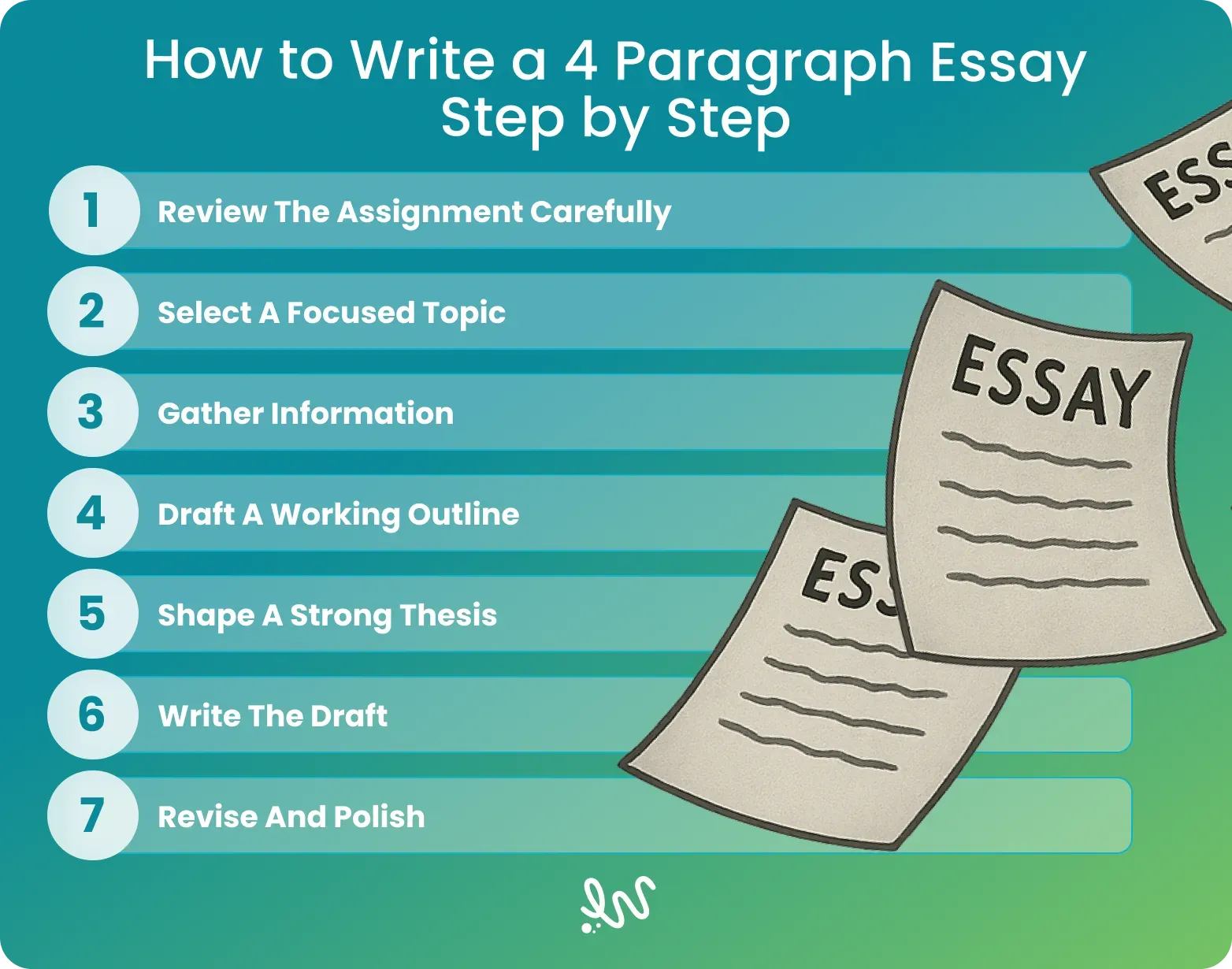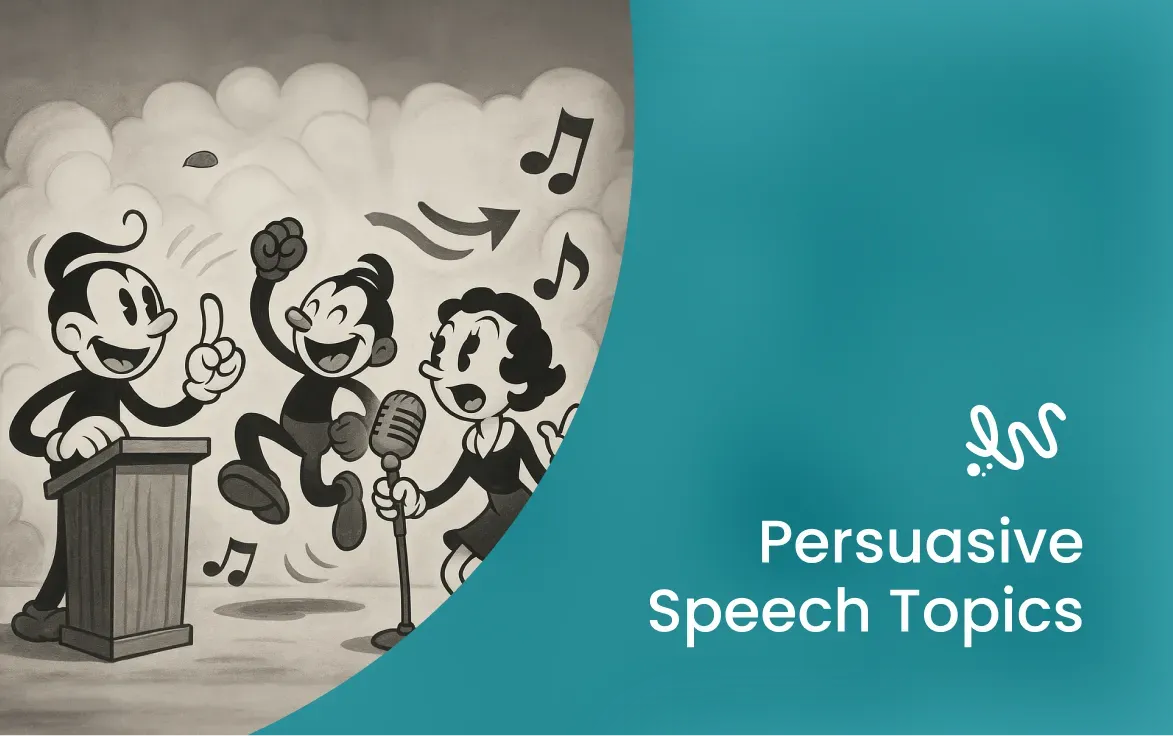A 4 paragraph essay is a concise structure for academic papers that includes an introduction, two body paragraphs, and a conclusion. This is the basic format for presenting your arguments in a limited scope. You'll usually run into this format in places where time is tight. High school teachers assign it when they want you to practice focus. Test makers favor it for short-answer essays. Even in professional settings, it helps explain or defend an idea without slipping into a long report.
This article will teach you the process of writing a 4 paragraph essay with clear steps. And when you feel your deadlines looming heavier than usual while you try to write better essays, you can always rely on WriteMyEssay to help you build papers you'll be proud to submit.

How to Structure a 4 Paragraph Essay?
The 4 paragraph essay structure is straightforward:
- Introduction
- Body Paragraphs
- Conclusion
Each part has its own job, and keeping that balance makes the essay flow naturally.
Paragraph 1: Introduction
The introduction paragraph lets the reader know what to expect from your essay. You must write it in a way that gives them a reason to keep reading. If we look at this part in more detail, we'll see that the introduction itself can also be broken down into several parts.
Hook
A hook is the opening line that grabs attention. It might be surprising or bold, so the reader immediately engages with your writing.
Example: "Social media has replaced the town square as the place where people celebrate and share news."
Thesis Statement
The thesis statement lays out the main point of the essay. In just a sentence or two, it must tell the reader exactly what your paper will argue.
Example: "While social media connects people, it also raises concerns about privacy and misinformation."
Leading Into the Body
This part links the introduction to the next section. It uses smooth phrasing and words to start a paragraph that guide the reader forward.
Example: "To see how social media shapes modern life, it helps to look at its influence on communication first."
Paragraph 2: First Point
The second section presents the first main point of your argument. It needs a structure of its own: you build a case layer by layer so the reader isn't confused at any point.
Topic Sentence
A topic sentence introduces the main idea of the paragraph in a few words. It points to what matters most in this part of the essay.
Example: "One major change brought by social media is the way people now share information online."
Check out our citation generator if you're struggling with building a reference list for your paper.
Supporting Evidence
No claim holds up without solid proof. Evidence backs up the point with facts and examples. This gives the paragraph authority.
Example: "Studies show that over 70% of teens get news updates through platforms like Instagram or TikTok."
Analysis
Analysis explains why the evidence matters. It connects the facts to your thesis. Mind the use of punctuation in this section because a misplaced comma or dash can derail the whole meaning.
Example: "This shift matters because when news is consumed in quick, fragmented posts, the depth of understanding often gets lost."
Transitional Statement
A transitional statement hints at what's coming next. It sets the stage for the following argument.
Example: "Beyond changing how people share news, social media has also reshaped personal relationships."
Paragraph 3: Second Point
The third paragraph continues the essay by adding new arguments and supporting evidence. Here, you introduce the second idea that links back to the thesis statement.
Think of it as the second pillar holding up the main idea that:
- Introduces a new point that relates to the thesis
- Expands the argument with a different angle or detail
- Keeps the essay balanced by avoiding repetition
- Builds momentum that leads naturally into the conclusion
Paragraph 4: Conclusion
The last paragraph closes the circle. It should:
- Bring the thesis back into focus
- Remind the reader of what has been said
- Leave a strong final impression
We will now dissect each part of the conclusion. Keep in mind that you must handle this section without repeating what you've already said before. Looking at examples of a conclusion will make it clearer that the best endings bring a sense of completion.
Thesis Restatement
Restating the thesis means going back to the central idea without repeating it word for word. This section proves that the essay never strayed from its purpose.
Example: "Social media now shapes both everyday conversation and the larger ways people understand the world."
Summary of Main Points
The concluding paragraph must also include a brief summarization of the body paragraphs. You need this to make sure the reader remembers the most important ground covered.
Example: "It has redefined how information spreads and how relationships are built in the digital age."
Closing Thought
You must close the essay with a thought that stays with the reader. It could point to the bigger picture or hint at what lies ahead. The best closing is something that leaves a thought worth carrying away.
Example: "As technology keeps moving forward, the role of social platforms in human connection will remain one of the most important questions we face."
How to Write a 4 Paragraph Essay?
The writing process for a four-paragraph essay begins long before you put the words out there. A strong essay comes, first of all, from careful planning. The best approach is always to follow a clear step-by-step approach.

Step 1: Review the Assignment Carefully
The first step is making sure you fully understand what's being asked. Read the instructions more than once and highlight important points. Pay attention to all requirements given by your professor. Pay attention to: required length or word count; type of essay; formatting rules; submission guidelines and deadlines.
Step 2: Select a Focused Topic
Choose a topic only after you've understood the requirements. Once you're sure you understand the requirements, you need to choose the topic. Since a four-paragraph essay format is inherently limited, broader themes are going to be harder to cover. Keep your topic narrow enough that you can fully describe it in only two body paragraphs.
Step 3: Gather Information
Carry out background research that will favor your argument. Gather facts and figures that directly support your claims. Avoid filling your notes with unrelated material since you only have limited space for the essentials. Your research should provide you with enough data to develop a convincing case.
Step 4: Draft an Outline
Chart out a rough structure before you start writing. Your outline should include the introductory paragraph, both body paragraphs, and the conclusion. You'll be able to save a lot of time and stress later on if you invest more time at this stage. Even a few brief bullet lists will be enough to keep you on track.
Step 5: Shape a Strong Thesis
You build your entire essay around the thesis statement. These couple of sentences present the main point you'll be arguing. By the end of it, your reader should know exactly what they should expect from the rest of the paper. The thesis statement must be very brief and specific so there are no questions about where you stand.
Step 6: Write the Draft
Now begin writing. Follow the outline as you turn each rough draft into full paragraphs. Use simple sentences and do not repeat anything you do not have to. Be very careful in choosing your words, especially in the words to use in essay conclusion (they will determine how the central point of your essay lands). A good first draft signifies having control over structure.
Step 7: Revise and Polish
Edit your writing like you're the strictest professor out there. Read aloud to catch awkward phrasing and adjust it as needed. Always check your essay for grammar because the smallest mistakes can weaken your arguments.
4 Paragraph Essay Examples
Take a look at three real examples of a four paragraph essay to better understand how to use the limited space to properly develop your arguments:
Closing Thoughts
Learning how to put together a 4 paragraph essay builds habits that carry into longer and more demanding assignments. The format may be brief, but it requires sharp focus and clear reasoning, which makes it a strong exercise for any student. This type of writing teaches you how to say everything you need to say as briefly as possible.
For those moments when writing feels overwhelming, you can just ask one of the writers on our platform, 'write my essay online' so they take over your assignments.

FAQ
How Many Words Should a 4 Paragraph Essay Be?
A 4 paragraph essay generally ranges from 250 to 500 words, though the exact length is shaped by the task and expectations. The main thing you must make sure of is that each section clearly states a point and provides support.
What Does a 4 Paragraph Essay Look Like?
This essay format opens with an introduction that presents the thesis. Then, you move into two body paragraphs that each expand on a distinct idea and support it with evidence. The concluding paragraph ties the discussion together.
How Many Sentences Are in a 4 Paragraph Essay?
Many 4 paragraph essays fall between twelve and twenty sentences in total, with three to five in each section.
Sources
- Naydan, L. (2019). How Do I Write an Intro, Conclusion, & Body Paragraph? | U-M LSA Sweetland Center for Writing. https://lsa.umich.edu/sweetland/undergraduates/writing-guides/how-do-i-write-an-intro--conclusion----body-paragraph.html
- Bartram, J. (n.d.). LibGuides: Writing academically: Paragraph structure. https://libguides.hull.ac.uk/writing/paras
- Linford, J. (2014). Essay Planning: Outlining with a Purpose What Is an Outline? How Do I Develop an Outline? https://www.sjsu.edu/writingcenter/docs/handouts/Essay%20Planning%20-%20Outlining.pdf



